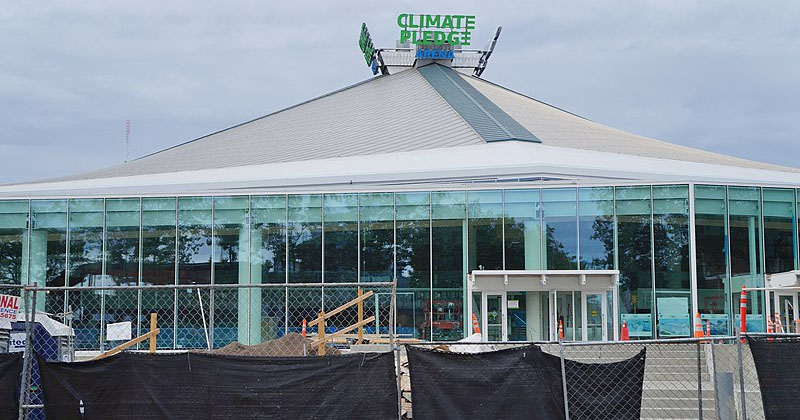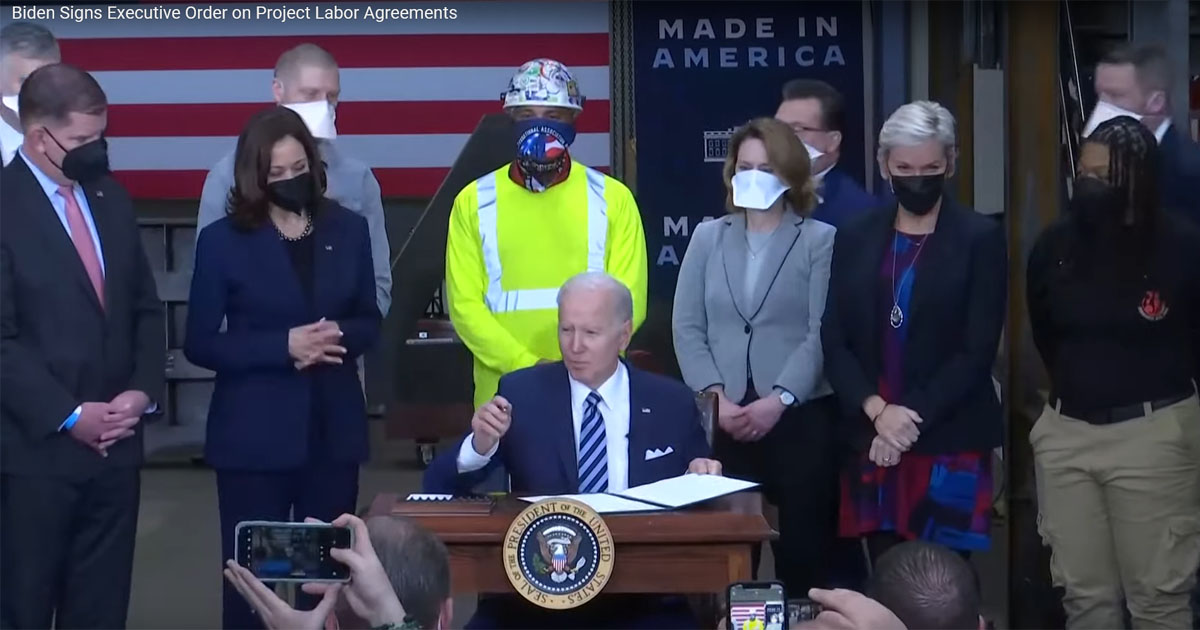NATIONAL
Biden’s order on federal PLAs to improve jobs for 200,000
The following is from the Economic Policy Institute:
WASHINGTON, D.C. (Feb. 10, 2022) — President Biden recently signed an executive order requiring project labor agreements (PLAs) on federal construction projects over $35 million, a move that is expected to affect $262 billion in federal construction contracting and improve job quality for nearly 200,000 workers.
PLAs are used primarily in the construction industry to establish the terms of employment for all workers on a project. Generally, PLAs specify workers’ wages and fringe benefits and may include provisions requiring contractors to hire workers through union hiring halls, otherwise establish a unionized workforce, or develop procedures for resolving employment disputes. PLAs often include language that prevents workers from striking during the project while also preventing employers from locking workers out.
PLAs are effective mechanisms for controlling construction costs, ensuring efficient completion of projects, and establishing fair wages and benefits for all workers. PLAs also help ensure worker health and safety protections while providing a unique opportunity for workforce development. These agreements can be written to engage local populations, provide jobs for underrepresented groups, and develop experience for apprentices.
Project labor agreements don’t raise construction costs
Evidence shows that PLAs do not increase construction costs. For example, New York City embarked on a $5.3 billion project in 2009, and the use of four PLAs was estimated to lead to 1,800 new jobs while saving the city approximately $300 million. A study from the Berkeley Labor Center also found that projects with PLAs attracted a “similar number of bidders” and “came in at a slightly lower price” when compared to projects without PLAs in place. Another 2015 paper from University of Utah economists compared nine PLA affordable housing projects with 121 affordable housing projects built without PLAs and found that the PLA projects were not more expensive to build.
These agreements are not union contracts. Both union and nonunion workers are given a chance to bid for contracts in a project involving PLAs. Opponents of PLAs argue that such agreements are illegal in states with so-called “right-to-work” laws due to an alleged “elimination of nonunion contractors.” However, a report from Cornell University adds that public-sector PLA bidding is “open and fair and cannot discriminate against nonunion contractors” because only the public interest is protected when securing “the best work for the money.” In other words, the PLA process includes a competitive bidding process that eliminates the risk of increased costs while also allowing laborers to come from a pool of both union and nonunion workers.
Project labor agreements are used widely and successfully
There are many examples of successful projects completed with the help of PLAs, and they have been used in large construction projects since the 1930s. PLAs have been extensively used in the private sector, including in the construction of Disney World in 1967, the Kennedy Space Center, and Yankee Stadium. Local governments have also used PLAs successfully for decades, such as in agreements for schools in Los Angeles which have been active since 1999 as well renovation and construction PLAs in New York City. Even large corporations such as Toyota, Walmart, and Delta Airlines use PLAs in manufacturing projects.

PLAs were successfully used for construction of all three of Seattle major sports stadiums: Lumen Field, T-Mobile Park, and the new Climate Pledge Arena. They’ve also been used for construction at Sea-Tac International Airport, Sound Transit, Naval Base Kitsap-Bangor, and on countless other major projects.
The Dulles Corridor Metrorail Project (DCMP) in Washington, D.C. used a PLA in Phase I of its construction, which started in 2009 and opened to the public in 2014. DCMP notes that the PLA included many cost-saving provisions, such as using “nonunion and merit-shop sub-contractors” in addition to union workers. This PLA provided cost-saving and organizational measures that led to the timely completion of a complex project, while also investing further in the community by providing good-paying jobs. The PLA was such a success that DCMP decided to require a PLA when planning for Phase II of the Dulles Metrorail extension.
Additionally, the City of Boston completed the largest public housing energy efficiency project in the nation’s history using a PLA in 2014. Upon completion, the city noted that the three-year, green construction project cost $66.7 million and renovated 13 public housing properties serving residents of 4,300 units. Boston estimated a 13,000-ton reduction in annual carbon dioxide emissions in addition to $4.8 million annual savings in energy and water costs. Boston expects to save $100 million over the next 20 years as a result of the renovations.
The Boston project also took advantage of the workforce development opportunities within PLAs. Officials note that the PLA created 600 jobs for “local union workers, public housing and low-income city residents, and small and minority-owned businesses.” A unique pre-apprenticeship program was developed as part of this project’s PLA as well, in which public housing and very low-income residents could participate in a training culminating in confirmed enrollment in apprenticeship opportunities.
Overall, Boston’s use of a PLA led to a successful clean energy renovation project that reinvested in the community, provided green jobs, and sparked educational programs all while developing sustainable affordable housing. In fact, the cost-saving measures of this project were so vast that the city expects the renovations to pay for themselves without additional taxpayer dollars.
Project labor agreement usage moving forward
President Biden’s recent EO demonstrates a strong commitment to improving efficiency, reducing costs, promoting workers’ well-being, and engaging local communities in large-scale government projects. As agencies work to implement the order, they should consider broader applications of PLAs outside of traditional brick-and-mortar projects. Creative usage of PLAs, like in Boston, can help support the transition to a clean energy economy that creates green jobs, trains workers in sustainable construction practices, and reinvests in local communities. PLAs can further strengthen efforts to improve broadband and water systems while guaranteeing strong labor standards. As President Biden seeks to modernize American infrastructure and American jobs, PLAs provide a unique opportunity to simultaneously do both.






